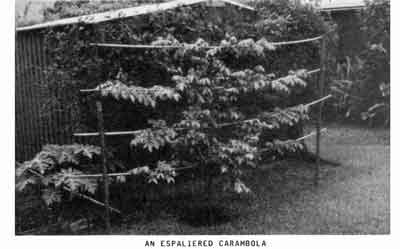
BACKYARD FRUIT GROWING - TAMARILLO AND CARAMBOLA
SCIENTIFIC NAME: Cyphomandra betacea
FAMILY: Solanaceae
SCIENTIFIC NAME: Averrhoa carambola
FAMILY: Oxalidaceae
TAMARILLO (Cyphomandra betacea)
Many years ago I grew Tamarillos in Uganda, in fact they had almost naturalised themselves around the area where I worked. Having developed a liking for the fruit, I decided to try and grow them once I got up to Cairns. I bought one fruit for 60 cents in the local supermarket, saved the seeds and raised some seedlings.
These I planted out and proceeded to give them TLC to absolutely no avail whatsoever! They grew only very slowly and most died out from what appeared to be collar rot. I suspect rootknot nematodes as well, which are rife in my garden. So I thought, let's try a rootstock of another Solanaceae species, but one which is very vigorous and reasonably long-lived, namely, the Potato Tree - Solanum macranthum.
This I found at the Cairns Botanic Gardens, and once fruit had set, I collected seed and raised the rootstocks, but selected only the most vigorous seedlings for grafting - about 25%.
Using scion material from my few surviving Tamarillo seedlings, which I dug up and potted to produce stronger plants, I cleft or approach grafted all the Potato Tree rootstocks.
It did not seem to matter that I was grafting two different genera together (Cyphomandra on Solanum), as they make a good union and are now nearly two years old and have commenced to fruit.
The fruit in this climate are not as highly coloured as in cooler southern climates. They seem to taste as good, but they don't seem to grow quite as large; it now remains to be seen if the rootstock can lengthen the life of what is normally only a short-lived tree, and if the fruit size increases as the trees develop and get stronger.
What is most noticeable is the variation in vigour between the trees. This could be due to variation in scion vigour (as they were from seedlings) but from memory, seedling Tamarillos in Uganda all grew fairly evenly. I rather think the variation is more due to the rootstock despite the fact that I only selected the most vigorous seedlings for potting on and grafting.
Perhaps the way to go is to select a vigorous and high-yielding Tamarillo seedling (on its own roots of course) and graft scions from this onto rooted cuttings from a selected, vigorous, Potato Tree rootstock. Might give that a go later on. The vigour of this combination should result in a large tree very quickly with plenty of new growth on which the tree produces its fruit.

CARAMBOLA (Averrhoa carambola)
Having won a grafted Carambola in a raffle at the last R.F.C. of A. AGM (but don't know the variety!) I planted it out in the garden. Being short of space, the usual story in suburbia, I decided to grow it on a trellis, as in the picture. I hope to confine the tree to four or more permanent arms, either way. The theory is to spur back lateral growth arising from the arms when it gets too long, a renewal system of pruning in other words.
Carambola fruits on new growth and should lend itself to this system of training quite well. Alternatively, the whole tree could be hedged.
When the tree fruited, all the fruit hung down from the arms in rows. The fruit is nice and sweet and has so far been untroubled by fruit fly, but I guess that will come eventually and I propose to use the lure.
The tree is growing in "spewy Edge Hill soil", as it was described to me by a local expert. Actually, it is a sort of structureless, fine-grained silt which sets like cement when it dries out. Therefore, before planting, a large hole was excavated down to about a metre, the soil discarded and the hole backfilled with well-rotted compost plus NPK fertilizer with trace elements.
Subsequent growth was vigorous and four arms were established either way along a trellis of bamboo canes spaced 33cm apart, perhaps a little too close. Maybe three arms in that space would have been better at 50cm apart. It is intended to install stronger posts and add another two or more arms either way as the tree gets bigger, the top arms being picked and pruned from a ladder.
So if you are short of space in the backyard, this highly-productive tree can still be grown confined to a trellis both aesthetically pleasing to the eye and useful as a screen to hide the compost heap, clothes hoist or whatever.
DATE: March 1992
* * * * * * * * * * * * *
